Configure and Verify Port-Channel on Firepower Appliances
Available Languages
Download Options
Bias-Free Language
The documentation set for this product strives to use bias-free language. For the purposes of this documentation set, bias-free is defined as language that does not imply discrimination based on age, disability, gender, racial identity, ethnic identity, sexual orientation, socioeconomic status, and intersectionality. Exceptions may be present in the documentation due to language that is hardcoded in the user interfaces of the product software, language used based on RFP documentation, or language that is used by a referenced third-party product. Learn more about how Cisco is using Inclusive Language.
Contents
Introduction
This document describes how to configure, verify, and troubleshoot the Port-Channel on Firepower Appliances.
Prerequisites
Requirements
Cisco recommends that you have knowledge of these topics:
- Firepower Management Center (FMC)
- Firepower Chassis Manager (FCM)
- Firepower eXtensible Operating System (FXOS)
- Firepower Threat Defense (FTD)
- EtherChannel (EC)

Note: In this document, the terms EtherChannel and Port-Channel (PC) are used interchangeably.
Components Used
The information in this document is based on these software and hardware versions:
- 2 x FPR4120 on FXOS 2.2(2.17), FTD 6.2.0.2.51
- 1 x FPR4110 on FXOS 2.1(0.159), FTD 6.1.0.330
- 1 x FPR2110 on FTD 6.2.1 (build 341)
- 1 x FPR1150 on FTD 6.5.0
- WS-C3750X-24 on15.2(4)E5
The information in this document was created from the devices in a specific lab environment. All of the devices used in this document started with a cleared (default) configuration. If your network is live, ensure that you understand the potential impact of any command.
Background Information
This document describes the configuration, verification and troubleshoot of a Port-Channel on Firepower Appliances (FPR1xxx, FPR21xx, FPR41xx, FPR93xx). The document configuration examples are based on Firepower Threat Defense (FTD), but many concepts (for example, the verification and troubleshoot) are fully applicable to Adaptive Security Appliance (ASA) as well.
Configure
Port-Channel on FPR4100/FPR9300
Network Diagram
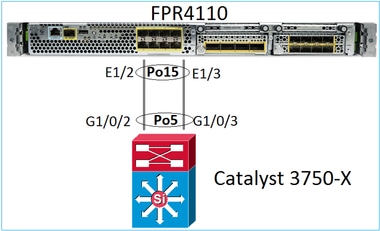
Configure a Port-Channel from FXOS User Interface (FPR4100/FPR9300)
FTD Port-Channel on Firepower Appliances is managed by the FXOS code. On FPR4100/FPR9300 the configuration is done from the Firepower Chassis Manager:
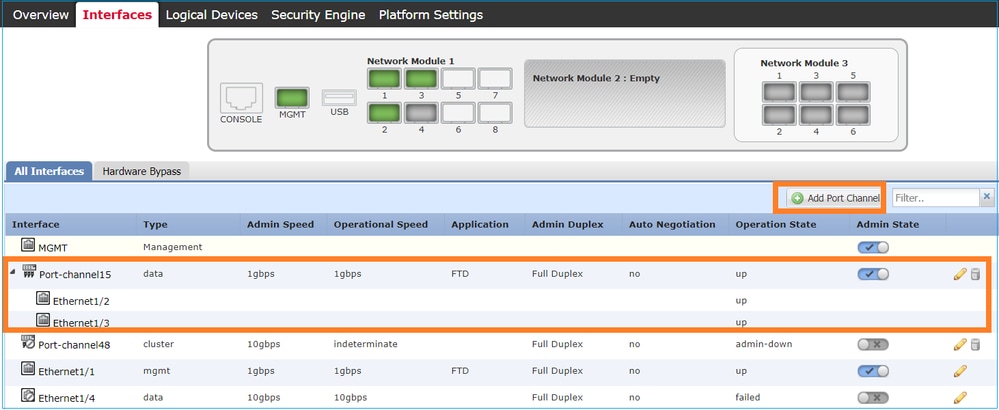
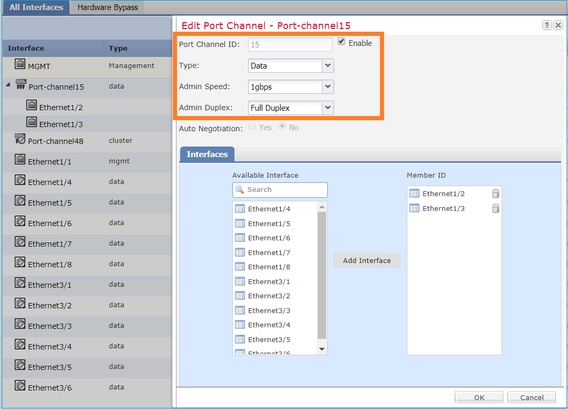
The Port-Channel is down (failed state) until it is assigned to a logical device:

To assign the Port-Channel to the logical device:
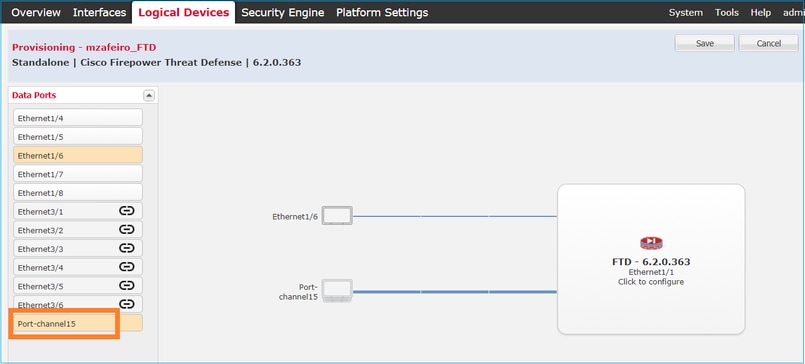
The result:
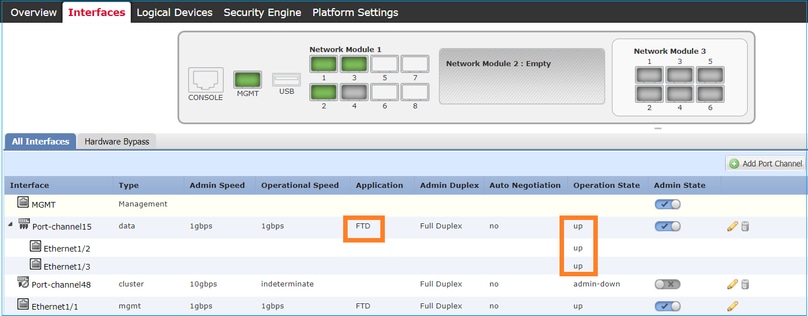
Main points
- Before FXOS 2.4.x release, the FPR4100/FPR9300 supports only LACP (no mode ON or PAGP). Since FXOS 2.4.1.101 mode ON is supported for data and data-sharing Etherchannels.
- Please ensure that the interface(s) which are to be added in the Port-Channel are not added already to the logical device. If they are, they do not show up in the interface when the Port-Channel is added.
- You cannot enable/disable individual Port-Channel members, but only the Port-Channel itself.
- You cannot delete a Port-Channel that is used by a Logical Device (for example, ASA or FTD). You must disassociate it first.
- The Port-Channel does not come up until you assign it to a logical device. If the EtherChannel is removed from the logical device or the logical device is deleted, the Port-Channel reverts to a Suspended state.
- Set the switch ports that connect to Active mode for the best compatibility.
Switch Configuration
When you configure the switch, in order to avoid Port-Channel instabilities it is recommended to:
- Use the interface range command.
- Shutdown the Port-Channel interface members before you make changes that affect the Port-Channel operation (for example, if the Port-Channel mode is changed).
Example
Switch(config)# interface range g1/0/2 - 3 Switch(config-if-range)# shutdown Switch(config-if-range)# switchport trunk encapsulation dot1q Switch(config-if-range)# switchport mode trunk Switch(config-if-range)# channel-group 5 mode active Switch(config-if-range)# no shutdown

Note: Always refer to the switch model Configuration Guide section for additional details.
Configure a Port-Channel from FXOS CLI (FPR4100/FPR9300)
Step 1. Verify the interfaces that are already assigned to the FTD logical device.
FP4110-7-A# scope ssa
FP4110-7-A /ssa # show logical-device
Logical Device:
Name Description Slot ID Mode Oper State Template Name
---------- ----------- ---------- ---------- ------------------------ -------------
mzafeiro_FTD 1 Standalone Ok ftd
FP4110-7-A /ssa # scope logical-device mzafeiro_FTD
FP4110-7-A /ssa/logical-device # show external-port-link
External-Port Link:
Name Port or Port Channel Name App Name Description
--------------- ------------------------- ---------- -----------
Ethernet11_ftd Ethernet1/1 ftd
Ethernet16_ftd Ethernet1/6 ftd
Step 2. Verify the chassis interfaces.
FP4110-7-A# scope eth-uplink
FP4110-7-A /eth-uplink # scope fabric a
FP4110-7-A /eth-uplink/fabric # show interface
Interface:
Port Name Port Type Admin State Oper State State Reason
--------------- ------------------ ----------- ---------------- ------------
Ethernet1/1 Mgmt Enabled Up
Ethernet1/2 Data Disabled Admin Down Administratively down
Ethernet1/3 Data Disabled Admin Down Administratively down
Ethernet1/4 Data Disabled Failed SFP checksum error
Ethernet1/5 Data Disabled Sfp Not Present Unknown
Ethernet1/6 Data Disabled Sfp Not Present Unknown
Ethernet1/7 Data Disabled Sfp Not Present Unknown
Ethernet1/8 Data Disabled Sfp Not Present Unknown
Ethernet3/1 Data Disabled Admin Down Administratively down
Ethernet3/2 Data Disabled Admin Down Administratively down
Ethernet3/3 Data Disabled Admin Down Administratively down
Ethernet3/4 Data Disabled Admin Down Administratively down
Ethernet3/5 Data Disabled Admin Down Administratively down
Ethernet3/6 Data Disabled Admin Down Administratively down
FP4110-7-A /eth-uplink/fabric # show port-channel
Port Channel:
Port Channel Id Name Port Type Admin State Oper State State Reason
--------------- ---------------- ------------------ ----------- ---------------- ------------
48 Port-channel48 Cluster Disabled Admin Down Administratively down
Step 3. Create the Port-Channel.
bsns-4110-2-A# scope eth-uplink bsns-4110-2-A /eth-uplink # scope fabric a bsns-4110-2-A /eth-uplink/fabric # create port-channel 15 bsns-4110-2-A /eth-uplink/fabric/port-channel* # create member-port Ethernet1/5 bsns-4110-2-A /eth-uplink/fabric/port-channel/member-port* # exit bsns-4110-2-A /eth-uplink/fabric/port-channel* # create member-port Ethernet1/6 bsns-4110-2-A /eth-uplink/fabric/port-channel/member-port* # exit bsns-4110-2-A /eth-uplink/fabric/port-channel* # set port-type data bsns-4110-2-A /eth-uplink/fabric/port-channel* # set speed 1gbps bsns-4110-2-A /eth-uplink/fabric/port-channel* # enable bsns-4110-2-A /eth-uplink/fabric/port-channel* # commit-buffer
Step 4. Assign the interface to the FTD logical device:
FP4110-7-A# scope ssa FP4110-7-A /ssa # scope logical-device mzafeiro_FTD FP4110-7-A /ssa/logical-device # create external-port-link PC15_ftd Port-channel15 ftd FP4110-7-A /ssa/logical-device/external-port-link* # commit-buffer FP4110-7-A /ssa/logical-device/external-port-link #
Verification
FP4110-7-A# scope ssa
FP4110-7-A /ssa # scope logical-device mzafeiro_FTD
FP4110-7-A /ssa/logical-device # show external-port-link
External-Port Link:
Name Port or Port Channel Name App Name Description
--------------- ------------------------- ---------- -----------
Ethernet11_ftd Ethernet1/1 ftd
Ethernet16_ftd Ethernet1/6 ftd
PC15_ftd Port-channel15 ftd
FP4110-7-A# scope eth-uplink
FP4110-7-A /eth-uplink # scope fabric a
FP4110-7-A /eth-uplink/fabric # show port-channel
Port Channel:
Port Channel Id Name Port Type Admin State Oper State State Reason
--------------- ---------------- ------------------ ----------- ---------------- ------------
15 Port-channel15 Data Enabled Up
48 Port-channel48 Cluster Disabled Admin Down Administratively down
FP4110-7-A /eth-uplink/fabric # enter port-channel 15
FP4110-7-A /eth-uplink/fabric/port-channel # show member-port
Member Port:
Port Name Membership Oper State State Reason
--------------- ------------------ ---------------- ------------
Ethernet1/2 Up Up
Ethernet1/3 Up Up
Delete the Port-Channel from FXOS CLI (FPR4100/FPR9300).
FP4110-7-A# scope eth-uplink FP4110-7-A /eth-uplink # scope fabric a FP4110-7-A /eth-uplink/fabric # delete port-channel 15 FP4110-7-A /eth-uplink/fabric* # commit-buffer
Port-Channel on FPR21xx/FPR1xxx
Network Diagram
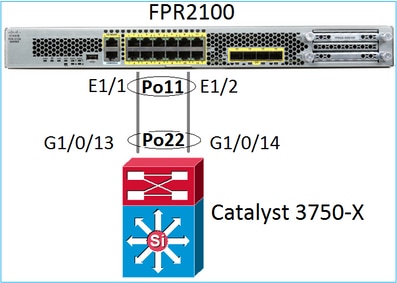
The FTD Port-Channel on FPR21xx/FPR1xxx appliances is managed by the FXOS code, but the configuration is done from the FMC since the FTD and FXOS code is integrated in one software bundle:
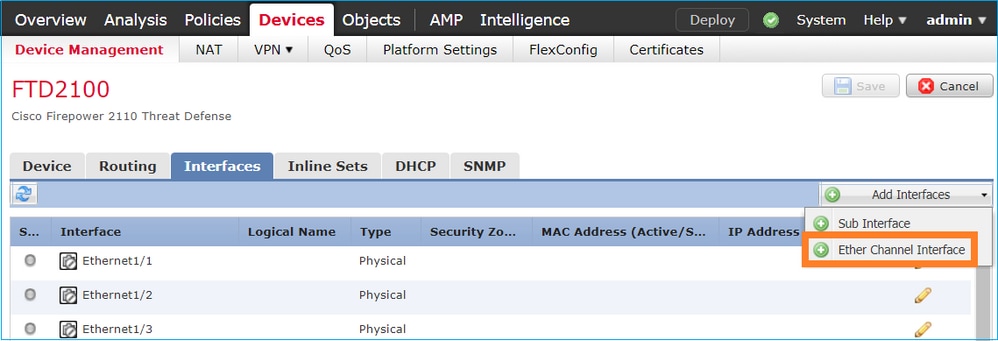
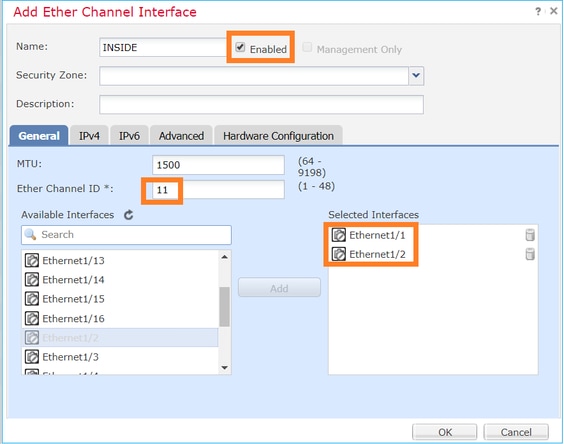
Mode (LACP Active or ON) are configured from the Advanced tab:
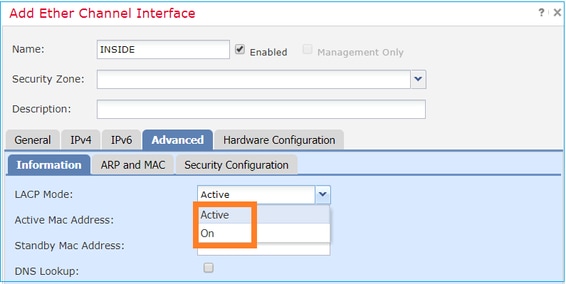
Duplex and Speed settings are configured from the Hardware Configuration tab:
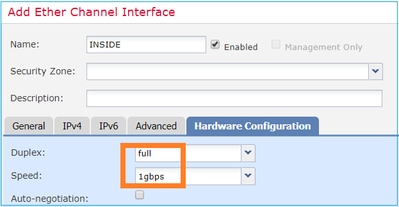

Note: On FPR2100, you cannot create a Port-Channel from FXOS CLI unless you use an ASA as a logical device. After ASA 9.13.x, this is the case only in Platform Mode. In Appliance Mode (11xx/21xx), there is not FCM and all interface configuration is performed directly in the ASA CLI.
Fp2110 /eth-uplink/fabric* # create port-channel 16 Fp2110 /eth-uplink/fabric/port-channel* # create member-port Ethernet1/10 Fp2110 /eth-uplink/fabric/port-channel/member-port* # exit Fp2110 /eth-uplink/fabric/port-channel* # create member-port Ethernet1/11 Fp2110 /eth-uplink/fabric/port-channel/member-port* # exit Fp2110 /eth-uplink/fabric/port-channel* # commit-buffer Error: Changes not allowed. use: 'connect ftd' to make changes.
In case a physical interface is down and you want to enable it do this:
firepower-2110# scope eth-uplink
firepower-2110 /eth-uplink # scope fabric a
firepower-2110 /eth-uplink/fabric # show interface
Interface:
Port Name Port Type Admin State Oper State State Reason
-------------- ------------------ ----------- ---------------- ------------
Ethernet1/3 Data Enabled Up Up
Ethernet1/4 Data Disabled Link Down Down
Ethernet1/5 Data Disabled Link Down Down
Ethernet1/6 Data Disabled Link Down Down
Ethernet1/7 Data Disabled Link Down Down
Ethernet1/8 Data Disabled Link Down Down
Ethernet1/9 Data Disabled Link Down Down
Ethernet1/10 Data Disabled Link Down Down
Ethernet1/11 Data Disabled Link Down Down
Ethernet1/12 Data Disabled Link Down Down
Ethernet1/13 Data Disabled Link Down Down
Ethernet1/14 Data Disabled Link Down Down
Ethernet1/15 Data Disabled Link Down Down
Ethernet1/16 Data Disabled Link Down Down
firepower-2110 /eth-uplink/fabric # enter interface Ethernet1/4
firepower-2110 /eth-uplink/fabric/interface # show
Interface:
Port Name Port Type Admin State Oper State State Reason
-------------- ------------------ ----------- ---------------- ------------
Ethernet1/4 Data Disabled Link Down Down
firepower-2110 /eth-uplink/fabric/interface # enable
firepower-2110 /eth-uplink/fabric/interface* # commit-buffer
firepower-2110 /eth-uplink/fabric/interface # show
Interface:
Port Name Port Type Admin State Oper State State Reason
-------------- ------------------ ----------- ---------------- ------------
Ethernet1/4 Data Enabled Link Down Down
firepower-2110 /eth-uplink/fabric/interface #
FDM Configuration
Consider this topology:

You can configure EtherChannel interfaces that use FDM as from 6.5 software release. Navigate to Device > Interfaces > EtherChannels and add an EtherChannel. Since in this case the EtherChannel is a trunk specify the EtherChannel ID, enable it (Status), and add the members. The EtherChannel supports LACP Active and mode On (no LACP). In this case, LACP Active mode is configured.

Add the Subinterfaces:
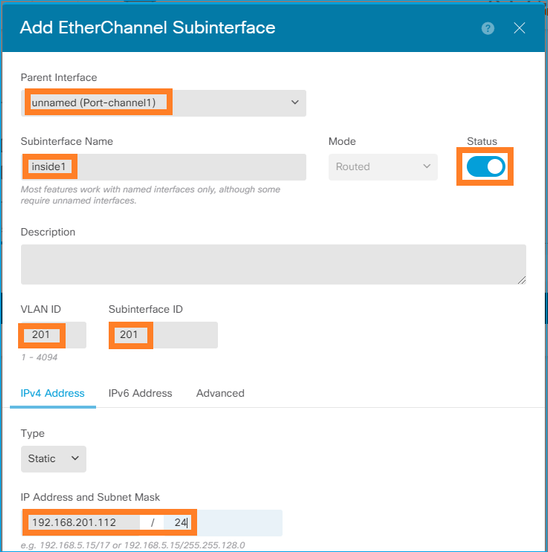
The result:

Deploy the expected changes.
Verify
Verify Port-Channel on FPR4100/FPR9300
Network Diagram
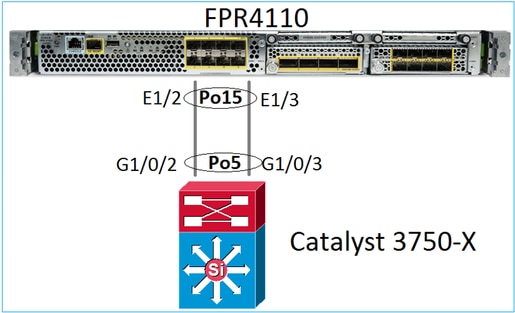
The FTD (or ASA) is not aware of the Port-Channel individual members. Logical interfaces (subinterfaces) are configured on FMC:
> system support diagnostic-cli firepower# show interface ip brief Interface IP-Address OK? Method Status Protocol Internal-Data0/0 unassigned YES unset up up Internal-Data0/1 unassigned YES unset up up Internal-Data0/2 169.254.1.1 YES unset up up Port-channel15 unassigned YES unset up up
firepower# show nameif Interface Name Security Port-channel15 INSIDE 0 Ethernet1/1 diagnostic 0
firepower# show interface Port-channel15 detail
Interface Port-channel15 "INSIDE", is up, line protocol is up
Hardware is EtherSVI, BW 20000 Mbps, DLY 1000 usec
MAC address 2c33.118e.07de, MTU 1500
IP address unassigned
Traffic Statistics for "INSIDE":
6767 packets input, 566328 bytes
0 packets output, 0 bytes
6736 packets dropped
1 minute input rate 4 pkts/sec, 375 bytes/sec
1 minute output rate 0 pkts/sec, 0 bytes/sec
1 minute drop rate, 4 pkts/sec
5 minute input rate 4 pkts/sec, 401 bytes/sec
5 minute output rate 0 pkts/sec, 0 bytes/sec
5 minute drop rate, 4 pkts/sec
Control Point Interface States:
Interface number is 6
Interface config status is active
Interface state is active
To check the status of the Port-Channel and its members, navigate to FXOS mode:
FP4110-7-A# connect fxos
FP4110-7-A(fxos)# show port-channel summary
Flags: D - Down P - Up in port-channel (members)
I - Individual H - Hot-standby (LACP only)
s - Suspended r - Module-removed
S - Switched R - Routed
U - Up (port-channel)
M - Not in use. Min-links not met
--------------------------------------------------------------------------------
Group Port- Type Protocol Member Ports
Channel
--------------------------------------------------------------------------------
15 Po15(SU) Eth LACP Eth1/2(P) Eth1/3(P)
48 Po48(SD) Eth NONE --
To see the state of the Port-Channels along with last state history:
FP4110-7-A(fxos)# show port-channel database
port-channel15
Last membership update is successful
2 ports in total, 2 ports up
First operational port is Ethernet1/3
Age of the port-channel is 0d:00h:35m:00s
Time since last bundle is 0d:00h:34m:56s
Last bundled member is Ethernet1/3
Ports: Ethernet1/2 [active ] [up]
Ethernet1/3 [active ] [up] *
port-channel48
Last membership update is successful
0 ports in total, 0 ports up
Age of the port-channel is 5d:06h:35m:27s
To check traffic distribution among Port-Channel interface members:
FP4110-7-A(fxos)# show port-channel traffic
ChanId Port Rx-Ucst Tx-Ucst Rx-Mcst Tx-Mcst Rx-Bcst Tx-Bcst
------ --------- ------- ------- ------- ------- ------- -------
15 Eth1/2 20.83% 49.71% 17.75% 43.67% 20.11% 49.94%
15 Eth1/3 79.16% 50.28% 82.24% 56.32% 79.88% 50.05%
LACP neighbor verification
FP4110-7-A(fxos)# show lacp neighbor
Flags: S - Device is sending Slow LACPDUs F - Device is sending Fast LACPDUs
A - Device is in Active mode P - Device is in Passive mode
port-channel15 neighbors
Partner's information
Partner Partner Partner
Port System ID Port Number Age Flags
Eth1/2 32768,28-6f-7f-ec-59-800x103 1984 FA
LACP Partner Partner Partner
Port Priority Oper Key Port State
32768 0x5 0x3f
Partner's information
Partner Partner Partner
Port System ID Port Number Age Flags
Eth1/3 32768,28-6f-7f-ec-59-800x104 2221 FA
LACP Partner Partner Partner
Port Priority Oper Key Port State
32768 0x5 0x3f
Partner Oper Key 0x5 = The switch is configured with Port-Channel ID 5.
On the switch:
Switch# show lacp neighbor
Flags: S - Device is requesting Slow LACPDUs
F - Device is requesting Fast LACPDUs
A - Device is in Active mode P - Device is in Passive mode
Channel group 5 neighbors
Partner's information:
LACP port Admin Oper Port Port
Port Flags Priority Dev ID Age key Key Number State
Gi1/0/2 FA 32768 2c33.118e.07b3 0s 0x0 0xE 0x42 0x3F
Gi1/0/3 FA 32768 2c33.118e.07b3 0s 0x0 0xE 0x43 0x3F

Note: On the adjacent Switch, the Partner Oper Key is shown as 0xE (14) although FXOS is configured with Port-Channel ID 15.
LACP packet capture in Wireshark:
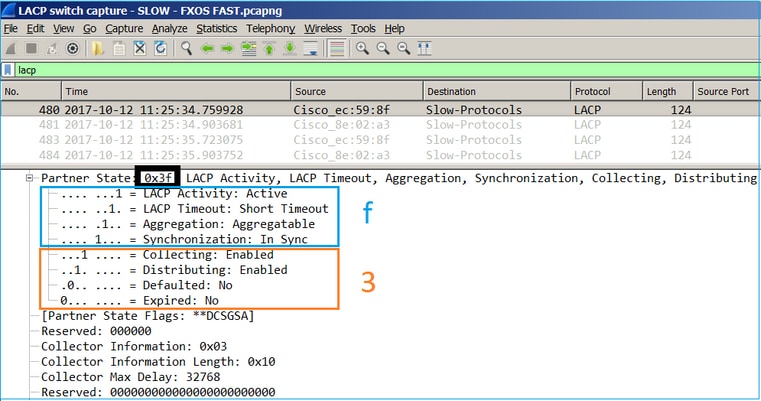
|
Partner State |
||||||||
|
State |
Expired |
Defaulted |
Distributed |
Collected |
Synchronization |
Aggregation |
LACP Timeout |
LACP Activity |
|
Value |
0 |
0 |
1 |
1 |
1 |
1 |
1 |
1 |
|
Hex |
3 |
f |
||||||
Verify Port-Channel on FPR21xx/FPR1xxx
Network Diagram
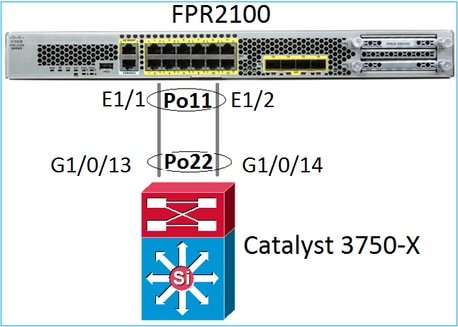
Port-Channel basic verification
> connect fxos
FP2110-2# connect local-mgmt
FP2110-2(local-mgmt)# show portchannel summary
Flags: D - Down P - Up in port-channel (members)
I - Individual H - Hot-standby (LACP only)
s - Suspended r - Module-removed
S - Switched R - Routed
U - Up (port-channel)
M - Not in use. Min-links not met
--------------------------------------------------------------------------------
Group Port- Type Protocol Member Ports
Channel
--------------------------------------------------------------------------------
11 Po11(U) Eth LACP Eth1/1(P) Eth1/2(P)
Additional verification:
FP2110-2# scope eth-uplink
FP2110-2 /eth-uplink # scope fabric a
FP2110-2 /eth-uplink/fabric # show port-channel
Port Channel:
Port Channel Id Name Port Type Admin State Oper State State Reason
--------------- ---------------- ------------------ ----------- ---------------- ------------
11 Port-channel11 Data Enabled Up Up
Verify the Port-Channel details:
FP2110-2 /eth-uplink/fabric # show port-channel detail
Port Channel:
Port Channel Id: 11
Name: Port-channel11
Port Type: Data
Description:
Admin State: Enabled
Oper State: Up
Auto negotiation: Yes
Speed: 1 Gbps
Duplex: Full Duplex
Oper Speed: 1 Gbps
Band Width (Gbps): 2
State Reason: Up
flow control policy: default
LACP policy name: default
oper LACP policy name: org-root/lacp-default
Lacp Mode: Active
Inline Pair Admin State: Enabled
Inline Pair Peer Port Name:
Verify the Port-Channel member details:
FP2110-2# scope eth-uplink
FP2110-2 /eth-uplink # scope fabric a
FP2110-2 /eth-uplink/fabric # scope port-channel 11 FP2110-2 /eth-uplink/fabric/port-channel # show member-port Member Port: Port Name Membership Oper State State Reason --------------- ------------------ ---------------- ------------ Ethernet1/1 Up Up Up Ethernet1/2 Up Up Up
Member port details:
FP2110-2 /eth-uplink/fabric/port-channel # show member-port detail
Member Port:
Port Name: Ethernet1/1
Membership: Up
Oper State: Up
State Reason: Up
Ethernet Link Profile name: default
Oper Ethernet Link Profile name: fabric/lan/eth-link-prof-default
Udld Oper State: Unknown
Current Task:
Port Name: Ethernet1/2
Membership: Up
Oper State: Up
State Reason: Up
Ethernet Link Profile name: default
Oper Ethernet Link Profile name: fabric/lan/eth-link-prof-default
Udld Oper State: Unknown
Current Task:
LACP verification
FP2110-2(local-mgmt)# show lacp neighbor
Flags: S - Device is requesting Slow LACPDUs
F - Device is requesting Fast LACPDUs
A - Device is in Active mode P - Device is in Passive mode
Channel group: 11
Partner (internal) information:
Partner Partner Partner
Port System ID Port Number Age Flags
Eth1/1 32768,286f.7fec.5980 0x10e 13 s FA <-- the peer is requesting Fast Rate
LACP Partner Partner Partner
Port Priority Oper Key Port State
32768 0x16 0x3f
Port State Flags Decode:
Activity: Timeout: Aggregation: Synchronization:
Active Long Yes Yes
Collected: Distributing: Defaulted: Expired:
Yes Yes No No
Partner Partner Partner
Port System ID Port Number Age Flags
Eth1/2 32768,286f.7fec.5980 0x10f 5 s FA <-- the peer is requesting Fast Rate
LACP Partner Partner Partner
Port Priority Oper Key Port State
32768 0x16 0x3f
Port State Flags Decode:
Activity: Timeout: Aggregation: Synchronization:
Active Long Yes Yes
Collected: Distributing: Defaulted: Expired:
Yes Yes No No

Note: On FPR21xx/FPR1xxx, the default LACP rate is Slow and cannot be changed.
LACP counters
FP2110-2(local-mgmt)# show lacp counters
LACPDUs Marker Marker Response LACPDUs
Port Sent Recv Sent Recv Sent Recv Pkts Err
---------------------------------------------------------------------
Channel group: 11
Eth1/1 4435 3532 0 0 0 0 0
Eth1/2 4566 3532 0 0 0 0 0
FP2110-2(local-mgmt)# show lacp counters
LACPDUs Marker Marker Response LACPDUs
Port Sent Recv Sent Recv Sent Recv Pkts Err
---------------------------------------------------------------------
Channel group: 11
Eth1/1 4436 3532 0 0 0 0 0
Eth1/2 4567 3532 0 0 0 0 0
FPR2100 interface verification
How the physical interfaces map to the FPR2100 internal Switch:
|
Interface |
Internal Switch on FPR2110/FPR2120 |
Internal Switch on FPR2130/FPR2140 |
|
E1/1 |
1 |
1 |
|
E1/2 |
0 |
0 |
|
E1/3 |
3 |
3 |
|
E1/4 |
2 |
2 |
|
E1/5 |
5 |
5 |
|
E1/6 |
4 |
4 |
|
E1/7 |
7 |
7 |
|
E1/8 |
6 |
6 |
|
E1/9 |
9 |
49 |
|
E1/10 |
8 |
48 |
|
E1/11 |
11 |
51 |
|
E1/12 |
10 |
50 |
|
E1/13 |
12 |
59 |
|
E1/14 |
13 |
58 |
|
E1/15 |
14 |
57 |
|
E1/16 |
15 |
56 |
|
E2/1 |
- |
70 |
|
E2/2 |
- |
71 |
|
E2/3 |
- |
69 |
|
E2/4 |
- |
68 |
|
E2/5 |
- |
66 |
|
E2/6 |
- |
67 |
|
E2/7 |
- |
65 |
|
E2/8 |
- |
64 |
Verify the physical interface status:
FP2110-2(local-mgmt)# show portmanager port-info ethernet 1 1
port_info:
if_index: 0x1081000
type: PORTMGR_IPC_MSG_PORT_TYPE_PHYSICAL
mac_address: 70:df:2f:18:d8:04
flowctl: PORTMGR_IPC_MSG_FLOWCTL_NONE
role: PORTMGR_IPC_MSG_PORT_ROLE_NPU
admin_state: PORTMGR_IPC_MSG_PORT_STATE_ENABLED
oper_state: PORTMGR_IPC_MSG_PORT_STATE_UP
admin_speed: PORTMGR_IPC_MSG_SPEED_AUTO
oper_speed: PORTMGR_IPC_MSG_SPEED_1GB
admin_mtu: 9216
admin_duplex: PORTMGR_IPC_MSG_PORT_DUPLEX_FULL
oper_duplex: PORTMGR_IPC_MSG_PORT_DUPLEX_FULL
pc_if_index: 0x200000b
pc_membership_status: PORTMGR_IPC_MSG_MMBR_UP
pc_protocol: PORTMGR_IPC_MSG_PORT_CHANNEL_PRTCL_LACP_ACTIVE
native_vlan: 1011
num_allowed_vlan: 1
allowed_vlan[0]: 1011
Physical interface counters:
FP2110-2(local-mgmt)# show portmanager counters ethernet 1 1 Good Octets Received : 2692986 Bad Octets Received : 0 MAC Transmit Error : 0 Good Packets Received : 37038 Bad Packets Received : 0 BRDC Packets Received : 22290 MC Packets Received : 12538 Size 64 : 34193 Size 65 to 127 : 1531 Size 128 to 255 : 1515 Size 256 to 511 : 374 Size 512 to 1023 : 95 Size 1024 to Max : 0 Good Octets Sent : 87296 Good Packets Sent : 682 Excessive Collision : 0 MC Packets Sent : 682 BRDC Packets Sent : 0 Unrecognized MAC Received : 0 FC Sent : 0 Good FC Received : 0 Drop Events : 0 Undersize Packets : 0 Fragments Packets : 0 Oversize Packets : 0 Jabber Packets : 0 MAC RX Error Packets Received : 0 Bad CRC : 0 Collisions : 0
FPR2100 internal switch MAC table.

Note: 01:80:C2:00:00:02 = LACP
FP2110-2(local-mgmt)# show portmanager switch mac-filters
port ix MAC mask action packets bytes
00 03e 70:DF:2F:18:D8:05 FF:FF:FF:FF:FF:FF FORWARD
043 01:80:C2:00:00:02 FF:FF:FF:FF:FF:FF FORWARD 687 87936
044 70:DF:2F:18:D8:2D FF:FF:FF:FF:FF:FF FORWARD
045 FF:FF:FF:FF:FF:FF FF:FF:FF:FF:FF:FF FORWARD 5501 385360
3d0 00:00:00:00:00:00 01:00:00:00:00:00 DROP 2101 141426
3e8 01:00:00:00:00:00 01:00:00:00:00:00 DROP 7946 1524820
01 03f 70:DF:2F:18:D8:04 FF:FF:FF:FF:FF:FF FORWARD
040 01:80:C2:00:00:02 FF:FF:FF:FF:FF:FF FORWARD 687 87936
041 70:DF:2F:18:D8:2D FF:FF:FF:FF:FF:FF FORWARD
042 FF:FF:FF:FF:FF:FF FF:FF:FF:FF:FF:FF FORWARD 22351 1451504
3d1 00:00:00:00:00:00 01:00:00:00:00:00 DROP 2215 154542
3e9 01:00:00:00:00:00 01:00:00:00:00:00 DROP 11886 1006067
02 03c 70:DF:2F:18:D8:07 FF:FF:FF:FF:FF:FF FORWARD
049 01:80:C2:00:00:02 FF:FF:FF:FF:FF:FF FORWARD
04a 70:DF:2F:18:D8:6D FF:FF:FF:FF:FF:FF FORWARD
04b FF:FF:FF:FF:FF:FF FF:FF:FF:FF:FF:FF FORWARD
3d2 00:00:00:00:00:00 01:00:00:00:00:00 DROP
3ea 01:00:00:00:00:00 01:00:00:00:00:00 DROP
Ports e1/1 and e1/2 correspond to 0/0 and 0/1 on the internal switch:
FP2110-2(local-mgmt)# show portmanager switch status Dev/Port Mode Link Speed Duplex Loopback Mode --------- ---------------- ----- ----- ------ ------------- 0/0 QSGMII Up 1G Full None 0/1 QSGMII Up 1G Full None 0/2 QSGMII Down 1G Half None 0/3 QSGMII Down 1G Half None 0/4 QSGMII Down 1G Half None 0/5 QSGMII Down 1G Half None 0/6 QSGMII Down 1G Half None 0/7 QSGMII Down 1G Half None 0/8 QSGMII Down 1G Half None 0/9 QSGMII Down 1G Half None 0/10 QSGMII Down 1G Half None 0/11 QSGMII Down 1G Half None 0/12 QSGMII Down 10 Half None 0/13 QSGMII Down 10 Half None 0/14 QSGMII Down 10 Half None 0/15 QSGMII Down 10 Half None 0/16 n/a Down n/a Full N/A 0/17 n/a Down n/a Full N/A 0/18 n/a Down n/a Full N/A 0/19 n/a Down n/a Full N/A 0/20 n/a Down n/a Full N/A 0/21 n/a Down n/a Full N/A 0/22 n/a Down n/a Full N/A 0/23 n/a Down n/a Full N/A 0/24 KR Up 10G Full None 0/25 KR Up 10G Full None 0/26 KR Down 10G Full None 0/27 KR Up 10G Full None
Troubleshoot
LACP Overview
LACP Facts:
- IEEE standard (802.3ad) Link Aggregation Control Protocol (LACP) is a L2 protocol used for Port-Channel negotiation.
- LACP uses destination MAC 0180.c200.0002 and Ethernet Type 0x8809.
- LACP and Mode On (no LACP) are the only modes supported on Firepower appliances (Mode On was added on FP4100/FP9300 in 2.4.x FXOS release).
- LACP can be configured in one of the 2 modes (Active or Passive). FXOS always uses an Active mode.
- The main goal of LACP is to protect from Port-Channel misconfigurations.
- In order for an LACP PC to come UP, there is a need to have the same Speed/Duplex settings in Port-Channel interface members. On FXOS you set the speed at the Port-Channel level.
- LACP Actor = the local device
- LACP Partner = the remote device
- Each device has an LACP System ID which usually is the chassis' MAC. The LACP System ID is sent within each LACP packet.
- Each LACP packet has ~110 Bytes of size.
- LACP can work in Fast Rate or Slow (Normal) Rate. For FXOS the default is Fast Rate (except 1xxx/21xx where it is always Slow), but it can also be configured as Slow. The LACP mode on the switch side depends on the switch model and SW used. For example, a Cat3750 supports both Slow and Fast as from 15.2(4)E. Check the switch confirmation guide for more details.
- In the LACP detection period, LACPs are sent every 1 sec no matter what is the LACP rate. The LACP rate affects only the LACP Keepalive interval once the interface is UP.
Benefits of LACP Keepalive
The LACP keepalive is helpful in scenarios when the remote interface is not functional anymore, but still UP (no direct failure was detected). This could be the case of driver/L2 problem or if there is some device in the path (for example, IPS) which does not allow the detection of remote link failures. LACP Keepalive has a timeout of peer rate x 3. For example, if the remote peer sends every 1 sec then the local device declares the remote peer down if no LACP packet is received within 3 sec. In the case of Slow Rate, this is after 90 sec.
All the fields of an LACP packet as they are shown in Wireshark:
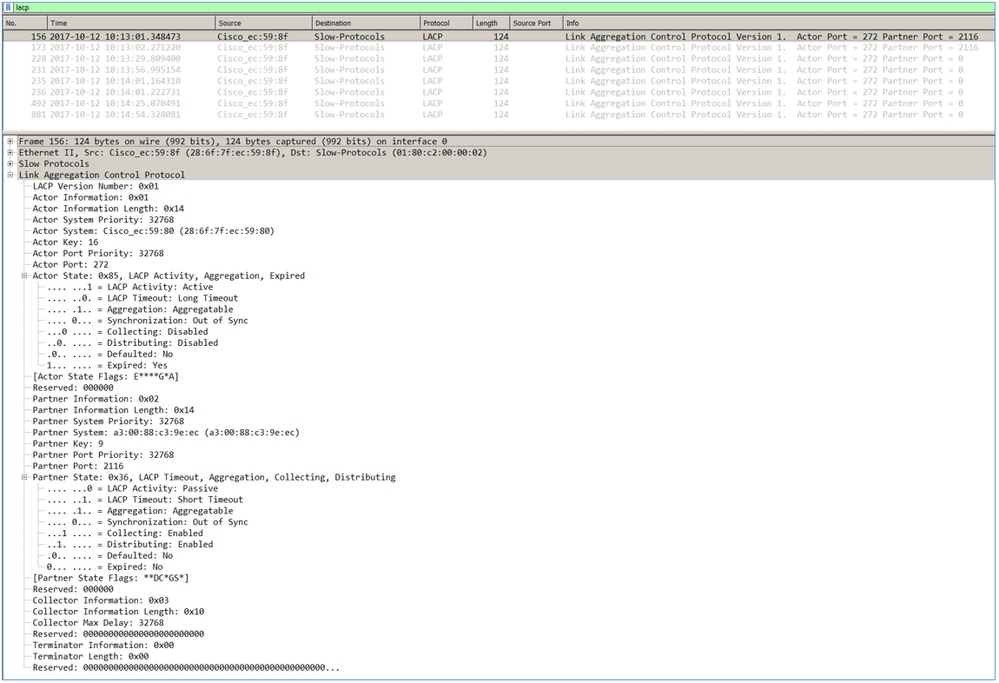

Note: When a port-channel is terminated on the FTD, the FXOS capture does not show LACP packets (ingress or egress).
LACP Fast Rate vs Slow Rate
In general, the recommendation is to use Fast Rate on both sides (FXOS on 4100/9300 uses Fast Rate by default, on FPR2100 the default LACP Send Rate is Slow). The LACP rate fast can increase the Port-Channel bundling speed.
|
FXOS Configured Slow |
FXOS Configured Fast |
|
|
Switch Configured Slow |
Switch requests Slow FXOS Requests Slow Switch sends 1 LACP/30sec FXOS sends 1 LACP/30sec |
Switch requests Slow FXOS Requests Fast Switch sends 1 LACP/sec FXOS sends 1 LACP/30sec |
|
Switch Configured Fast |
Switch requests Fast FXOS Requests Slow Switch sends 1 LACP/30sec FXOS sends 1 LACP/sec |
Switch requests Fast FXOS Requests Fast Switch sends 1 LACP/sec FXOS sends 1 LACP/sec |
To configure the LACP mode on FXOS (41xx/93xx):
KSEC-FPR4100-1# scope org
KSEC-FPR4100-1 /org # show lacppolicy
LACP policy:
Name LACP rate
---------- ---------
default Fast
KSEC-FPR4100-1 /org # scope lacppolicy default
KSEC-FPR4100-1 /org/lacppolicy # set lacp-rate
fast lacp rate fast
normal lacp rate normal
Troubleshoot Port-Channel on FPR4100/FPR9300
Network Diagram
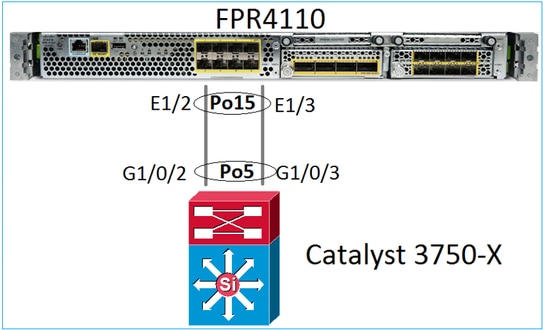
The FPR4100 and FPR9300 chassis contain an internal switch where the Port-Channel is terminated. Since the internal switch is similar to a Nexus 5K and FXOS supports only LACP the troubleshoot approach is similar to a Nexus 5K.
Check 1 – Verify the Port-Channel status.
FP4110-7-A(fxos)# show port-channel summary
Flags: D - Down P - Up in port-channel (members)
I - Individual H - Hot-standby (LACP only)
s - Suspended r - Module-removed
S - Switched R - Routed
U - Up (port-channel)
M - Not in use. Min-links not met
--------------------------------------------------------------------------------
Group Port- Type Protocol Member Ports
Channel
--------------------------------------------------------------------------------
15 Po15(SU) Eth LACP Eth1/2(P) Eth1/3(P)
Verify the FXOS interface status:
FP4110-7-A(fxos)# show interface brief -------------------------------------------------------------------------------- Ethernet VLAN Type Mode Status Reason Speed Port Interface Ch # -------------------------------------------------------------------------------- Eth1/1 1 eth 1qtunl up none 1000(D) -- Eth1/2 1 eth 1qtunl up none 1000(D) 15 Eth1/3 1 eth 1qtunl up none 1000(D) 15 Eth1/4 1 eth 1qtunl down SFP not inserted 10G(D) -- Eth1/5 1 eth 1qtunl down Administratively down 1000(D) -- Eth1/6 1 eth 1qtunl down Administratively down 1000(D) -- Eth1/7 1 eth 1qtunl down Administratively down 10G(D) -- Eth1/8 1 eth 1qtunl down SFP not inserted 10G(D) -- Eth1/9 1 eth vntag up none 40G(D) -- Eth1/10 1 eth access down Administratively down 40G(D) -- Eth1/11 1 eth access down Administratively down 1000(D) -- Eth1/12 1 eth access down Administratively down 1000(D) --
Check 2 – Verify that the FXOS sends and receives LACPs (run the command a few times).
FP4110-7-A(fxos)# show lacp counters interface port-channel 15
LACPDUs Marker Marker Response LACPDUs
Port Sent Recv Sent Recv Sent Recv Pkts Err
---------------------------------------------------------------------
port-channel15
Ethernet1/2 223019 207280 0 0 0 0 0
Ethernet1/3 296532 207744 0 0 0 0 0
Verify the same on the switch:
Switch# show lacp 5 counters
LACPDUs Marker Marker Response LACPDUs
Port Sent Recv Sent Recv Sent Recv Pkts Err
---------------------------------------------------------------------
Channel group: 5
Gi1/0/2 627 596 0 0 0 0 0
Gi1/0/3 623 593 0 0 0 0 0
Verify the LACP details of an individual FXOS interface:
FP4110-7-A(fxos)# show lacp interface ethernet 1/2 Interface Ethernet1/2 is up Channel group is 15 port channel is Po15 PDUs sent: 222828 PDUs rcvd: 207074 Markers sent: 0 Markers rcvd: 0 Marker response sent: 0 Marker response rcvd: 0 Unknown packets rcvd: 0 Illegal packets rcvd: 0 Lag Id: [ [(8000, 28-6f-7f-ec-59-80, 5, 8000, 103), (8000, 2c-33-11-8e-7-b3, e, 8000, 42)] ] Operational as aggregated link since Tue Oct 31 19:14:57 2017 Local Port: Eth1/2 MAC Address= 2c-33-11-8e-7-b3 System Identifier=0x8000,2c-33-11-8e-7-b3 Port Identifier=0x8000,0x42 Operational key=14 LACP_Activity=active LACP_Timeout=Short Timeout (1s) Synchronization=IN_SYNC Collected=true Distributing=true
Check 3 - Verify the LACP IDs of the local and remote device.
FP4110-7-A(fxos)# show lacp port-channel interface port-channel 15 port-channel15 System Mac=2c-33-11-8e-7-b3 Local System Identifier=0x8000,2c-33-11-8e-7-b3 Admin key=0xe Operational key=0xe Partner System Identifier=0x8000,28-6f-7f-ec-59-80 Operational key=0x5 Max delay=0 Aggregate or individual=1 Member Port List=
Check 4 (optional) - Collect this output (can be used by Cisco TAC).
FP4110-7-A(fxos)# show lacp internal event-history errors
1) Event:E_DEBUG, length:74, at 574387 usecs after Tue Oct 31 19:14:57 2017
[102] lacp_proto_set_ntt(1780): Restarting periodic tx timer in 0x210 msecs
2) Event:E_DEBUG, length:467, at 544757 usecs after Tue Oct 31 19:14:57 2017
[102] lacp_ac_init_port_channel_member(1660): TYPE1 UPDATE lacp_ac_init_port
_channel_member port-channel port-channel15(0x1600000e) lacp_mcec_type1_upd_sent
...
Check 5 - Check the LACP FSM transition for the specific port that has the problem. The messages are shown with the oldest at the top of the output.
FP4110-7-A(fxos)# show lacp internal event-history interface ethernet 1/2
>>>>FSM: <Ethernet1/2> has 975 logged transitions<<<<<
1) FSM:<Ethernet1/2> Transition at 257150 usecs after Sun Oct 29 12:35:16 2017
Previous state: [LACP_ST_WAIT_FOR_HW_TO_PROGRAM_RECEIVE_PATH]
Triggered event: [LACP_EV_PORT_RECEIVE_PATH_ENABLED_AS_CHANNEL_MEMBER_MESSAGE]
Next state: [LACP_ST_PORT_MEMBER_RECEIVE_ENABLED]
...
4) FSM:<Ethernet1/2> Transition at 966987 usecs after Sun Oct 29 12:35:19 2017
Previous state: [LACP_ST_PORT_MEMBER_COLLECTING_AND_DISTRIBUTING_ENABLED]
Triggered event: [LACP_EV_PARTNER_PDU_IN_SYNC] <--- Good (Received LACP with ‘Synchronization = 1’
Next state: [LACP_ST_PORT_IS_DOWN_OR_LACP_IS_DISABLED]
...
207) FSM:<Ethernet1/4> Transition at 482767 usecs after Sun Oct 29 13:18:40 2017
Previous state: [LACP_ST_ATTACHED_TO_AGGREGATOR]
Triggered event: [LACP_EV_PARTNER_PDU_OUT_OF_SYNC]
Next state: [FSM_ST_NO_CHANGE]
208) FSM:<Ethernet1/4> Transition at 363720 usecs after Sun Oct 29 13:18:41 2017
Previous state: [LACP_ST_ATTACHED_TO_AGGREGATOR]
Triggered event: [LACP_EV_PARTNER_PDU_OUT_OF_SYNC] <--- Bad (Received LACP with ‘Synchronization = 0’
Next state: [FSM_ST_NO_CHANGE]Check 6 - Collect the Port-Channel event history (can be used by Cisco TAC).
FP4110-7-A(fxos)# show port-channel internal event-history all
Low Priority Pending queue: len(0), max len(1) [Tue Oct 31 19:37:03 2017] High Priority Pending queue: len(0), max len(12) [Tue Oct 31 19:37:03 2017] PCM Control Block info: pcm_max_channels : 4096 pcm_max_channel_in_use : 48 pc count : 2 hif-pc count : 0 Max PC Cnt : 104 Load-defer timeout : 120 ==================================================== PORT CHANNELS: 2LvPC PO in system : 0 port-channel15 channel : 15 bundle : 65535 ... >>>>FSM: <eth-port-channel 15> has 66 logged transitions<<<<< 1) FSM:<eth-port-channel 15> Transition at 174796 usecs after Tue Oct 31 18:05:0 8 2017 Previous state: [PCM_PC_ST_INIT] Triggered event: [PCM_PC_EV_CREATE_INIT] Next state: [FSM_ST_NO_CHANGE] 2) Event:ESQ_START length:38, at 174810 usecs after Tue Oct 31 18:05:08 2017 Instance:369098766, Seq Id:0x1, Ret:SUCCESS Seq Type:SERIAL ...Troubleshoot Port-Channel on FPR21xx/FPR1xxx
Network Diagram
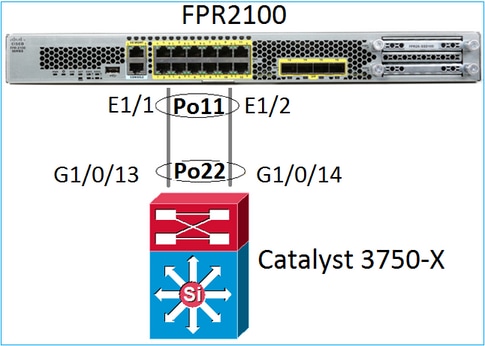
Check 1. In case LACP is used, verify the LACP counters.
You see both sides (switch and FXOS) send and receive:
FP2110-2(local-mgmt)# show lacp counters
LACPDUs Marker Marker Response LACPDUs
Port Sent Recv Sent Recv Sent Recv Pkts Err
---------------------------------------------------------------------
Channel group: 11
Eth1/1 4435 3532 0 0 0 0 0
Eth1/2 4566 3532 0 0 0 0 0
Another way to verify the same:
FP2110-2(local-mgmt)# show pktmgr counters
Ports Tx Tx Tx Rx Rx Rx Rx
Packets Drops Bytes Packets Drops Bytes Forwards
----------------------------------------------------------------------------
Eth1/1 4575 0 567300 3537 0 452736 3537 < LACP PDUs forwarded internally to LACP process
Eth1/2 4706 0 583544 3537 0 452736 3537 < LACP PDUs forwarded internally to LACP process
Eth1/3 0 0 0 0 0 0 0
Eth1/4 0 0 0 0 0 0 0
Eth1/5 0 0 0 0 0 0 0
Eth1/6 0 0 0 0 0 0 0
Eth1/7 0 0 0 0 0 0 0
Eth1/8 0 0 0 0 0 0 0
Eth1/9 0 0 0 0 0 0 0
Eth1/10 0 0 0 0 0 0 0
Eth1/11 0 0 0 0 0 0 0
Eth1/12 0 0 0 0 0 0 0
Eth1/13 0 0 0 0 0 0 0
Eth1/14 0 0 0 0 0 0 0
Eth1/15 0 0 0 0 0 0 0
Eth1/16 0 0 0 0 0 0 0
Misc. 0 0 0 0 0 0 n/a
Check 2. Verify the upstream switch status.
FP2110-2(local-mgmt)# show lacp neighbor
Flags: S - Device is requesting Slow LACPDUs
F - Device is requesting Fast LACPDUs
A - Device is in Active mode P - Device is in Passive mode
Channel group: 11
Partner (internal) information:
Partner Partner Partner
Port System ID Port Number Age Flags
Eth1/1 32768,286f.7fec.5980 0x10e 9 s FA
LACP Partner Partner Partner
Port Priority Oper Key Port State
32768 0x16 0x3f
Port State Flags Decode:
Activity: Timeout: Aggregation: Synchronization:
Active Long Yes Yes
Collected: Distributing: Defaulted: Expired:
Yes Yes No No
Partner Partner Partner
Port System ID Port Number Age Flags
Eth1/2 32768,286f.7fec.5980 0x10f 24 s FA
LACP Partner Partner Partner
Port Priority Oper Key Port State
32768 0x16 0x3f
Port State Flags Decode:
Activity: Timeout: Aggregation: Synchronization:
Active Long Yes Yes
Collected: Distributed: Defaulted: Expired:
Yes Yes No No

Note: If Collected and Distributed are not Yes and Defaulted is No then LACP is not converged.
Check 3. Verify that the local LACP system-ID is not 0.
FP2110-2(local-mgmt)# show lacp sys-id 32768, 70df.2f18.d813
Additional Troubleshoot (Common in all Platforms)
Check 1
Ensure that both sides (Firewall and switch) have matched settings (for example, Speed is the same, Port-Channel mode is the same).
Check 2
Check for FXOS faults. You can do this check from the chassis User Interface (UI) or from the CLI that uses this command:
FPR4100# show fault Severity Code Last Transition Time ID Description --------- -------- ------------------------ -------- ----------- Major F0479 2020-03-19T11:50:44.322 543322 Virtual interface 781 link state is down Major F0373 2020-03-19T10:55:13.778 34178 Fan 1 in Fan Module 1-5 under chassis 1 operability: inoperable Minor F0480 2020-03-19T10:55:13.777 34177 Fan module 1-5 in chassis 1 operability: degraded Major F1767 2020-03-19T10:54:04.162 531228 The password encryption key has not been set. Major F0727 2020-03-19T09:50:02.891 522921 lan Member 1/5 of Port-Channel 10 on fabric interconnect A is down, membership: suspended Major F0282 2020-03-19T09:49:31.462 522922 lan port-channel 10 on fabric interconnect A oper state: failed, reason: No operational members Major F0277 2020-03-19T09:49:31.437 522929 ether port 1/5 on fabric interconnect A oper state: failed, reason: Other Info F0279 2020-01-17T11:06:45.472 300958 ether port 1/7 on fabric interconnect A oper state: sfp-not-present Info F0279 2020-01-17T11:06:37.941 300903 ether port 1/6 on fabric interconnect A oper state: sfp-not-present Minor F1437 2020-01-16T10:11:39.675 291723 Config backup may be outdated
The faults are shown in chronological order. The Severity reflects the importance of the fault, while the description provides a brief overview. The focus is mainly on the severity, the timestamp, and the description. The fault severity order from most severe to least severe is:
- Critical
- Major
- Minor
- Warning
- Info/Condition
- Cleared
For details about each fault check the FXOS Faults and Error Messages guide: FXOS Error and System Messages
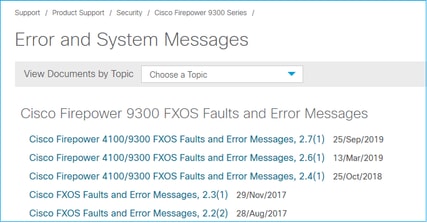
Check 3
If you did some recent changes related to Port-Channel configuration on FMC, ensure that the policy was deployed from FMC to FTD.
Check 4
If the Port-Channel is in Failed state, and the device belongs to a Cluster, then ensure that the Cluster is enabled on the device. A device that is kicked off the cluster is normal to have the Port-Channel in a failed state.
Check 5
If the configuration is correct, but the interface does not come UP check and replace the cable and/or Small Form-Factor Pluggable (SFP) transceiver.
Check 6
Check the firepower Release Notes for known issues related to Port-Channel. For example, if you run FXOS version 2.6.1.169 and FTD 6.4.0.6 check these sections:
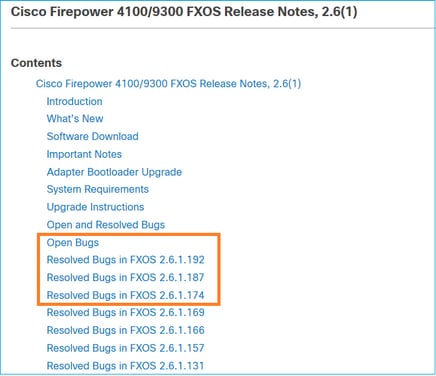
Additionally, check the related FMC/FTD Release Notes. Since in this example the FTD runs 6.4.0.5 there is need to check the 6.4.x Release Notes:
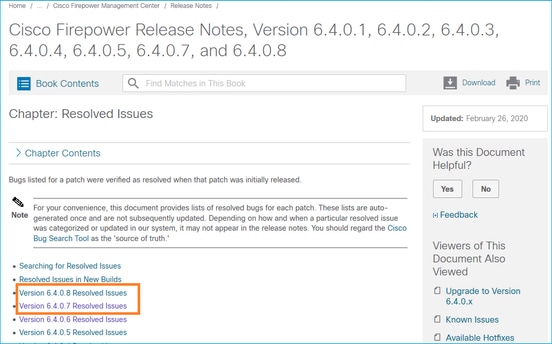
Common Issues
Case 1. EtherChannel Mode Mismatch
Consider this topology:
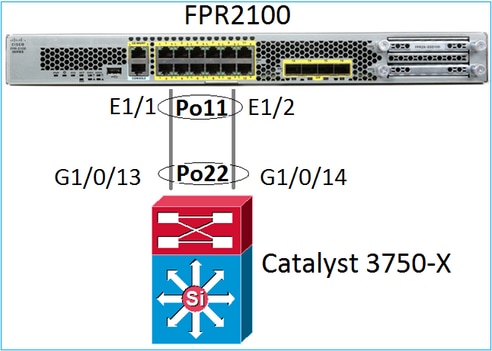
The Problem Symptoms
On Firepower the Port-Channel is Down and the Negotiation protocol is LACP:
FP2110-2(local-mgmt)# show portchannel summary
Flags: D - Down P - Up in port-channel (members)
I - Individual H - Hot-standby (LACP only)
s - Suspended r - Module-removed
S - Switched R - Routed
U - Up (port-channel)
M - Not in use. Min-links not met
--------------------------------------------------------------------------------
Group Port- Type Protocol Member Ports
Channel
--------------------------------------------------------------------------------
11 Po11(D) Eth LACP Eth1/1(D) Eth1/2(D)
On FXOS the LACP Sent counters increment every 30 sec, but the Receive counters do not:
FP2110-2(local-mgmt)# show lacp counters
LACPDUs Marker Marker Response LACPDUs
Port Sent Recv Sent Recv Sent Recv Pkts Err
---------------------------------------------------------------------
Channel group: 11
Eth1/1 11356 3762 0 0 0 0 0
Eth1/2 11393 3761 0 0 0 0 0
FP2110-2(local-mgmt)# show lacp counters
LACPDUs Marker Marker Response LACPDUs
Port Sent Recv Sent Recv Sent Recv Pkts Err
---------------------------------------------------------------------
Channel group: 11
Eth1/1 11357 3762 0 0 0 0 0
Eth1/2 11394 3761 0 0 0 0 0
The Root Cause
The Port-Channel on the switch is UP, but notice the absence of Negotiation protocol:
Switch# show etherchannel 22 summary … Number of channel-groups in use: 15 Number of aggregators: 15 Group Port-channel Protocol Ports ------+-------------+-----------+----------------------------------------------- 22 Po22(SU) - Gi1/0/13(P) Gi1/0/14(P)
The switch port configuration confirms this:
Switch# show run int g1/0/13 interface GigabitEthernet1/0/13 lacp rate fast channel-group 22 mode on end Switch# show run int g1/0/14 interface GigabitEthernet1/0/14 lacp rate fast channel-group 22 mode on end
Solution
Since this is an FPR21xx appliance, there are 2 possible solutions:
- Change the Port-Channel mode on the switch side from ON to LACP (Active or Passive).
- Change the Port-Channel mode on the FTD side from LACP to ON.
In this scenario, the second solution was chosen (set FTD Port-Channel to mode ON):
FP2110-2(local-mgmt)# show portchannel summary
Flags: D - Down P - Up in port-channel (members)
I - Individual H - Hot-standby (LACP only)
s - Suspended r - Module-removed
S - Switched R - Routed
U - Up (port-channel)
M - Not in use. Min-links not met
--------------------------------------------------------------------------------
Group Port- Type Protocol Member Ports
Channel
--------------------------------------------------------------------------------
11 Po11(U) Eth ON Eth1/1(P) Eth1/2(P)
The LACP counters are not shown any more:
FP2110-2(local-mgmt)# show lacp counters FP2110-2(local-mgmt)#
Case 2. Wrong Port-Channel Design
The Problem Symptoms
FP4110-7-A(fxos)# show port-channel summary
Flags: D - Down P - Up in port-channel (members)
I - Individual H - Hot-standby (LACP only)
s - Suspended r - Module-removed
S - Switched R - Routed
U - Up (port-channel)
M - Not in use. Min-links not met
--------------------------------------------------------------------------------
Group Port- Type Protocol Member Ports
Channel
--------------------------------------------------------------------------------
15 Po15(SD) Eth LACP Eth1/2(P) Eth1/3(s)
48 Po48(SD) Eth NONE --
FXOS LACP counters increase in both directions:
FP4110-7-A(fxos)# show lacp counters
LACPDUs Marker Marker Response LACPDUs
Port Sent Recv Sent Recv Sent Recv Pkts Err
---------------------------------------------------------------------
port-channel15
Ethernet1/2 419219 451268 0 0 0 0 0
Ethernet1/3 419215 446806 0 0 0 0 0
FP4110-7-A(fxos)# show lacp counters
LACPDUs Marker Marker Response LACPDUs
Port Sent Recv Sent Recv Sent Recv Pkts Err
---------------------------------------------------------------------
port-channel15
Ethernet1/2 419219 451269 0 0 0 0 0
Ethernet1/3 419216 446807 0 0 0 0 0
The Root Cause
The output of show lacp neighbor shows different Partner System ID on each port:
FP4110-7-A(fxos)# show lacp neighbor
Flags: S - Device is sending Slow LACPDUs F - Device is sending Fast LACPDUs
A - Device is in Active mode P - Device is in Passive mode
port-channel15 neighbors
Partner's information
Partner Partner Partner
Port System ID Port Number Age Flags
Eth1/2 32768,28-6f-7f-ec-59-800x103 419611 FA
LACP Partner Partner Partner
Port Priority Oper Key Port State
32768 0x5 0x3d
Partner's information
Partner Partner Partner
Port System ID Port Number Age Flags
Eth1/3 32768,4-62-73-d2-65-0 0x12f 419610 SA
LACP Partner Partner Partner
Port Priority Oper Key Port State
32768 0x16 0xd
This can be visualized as:
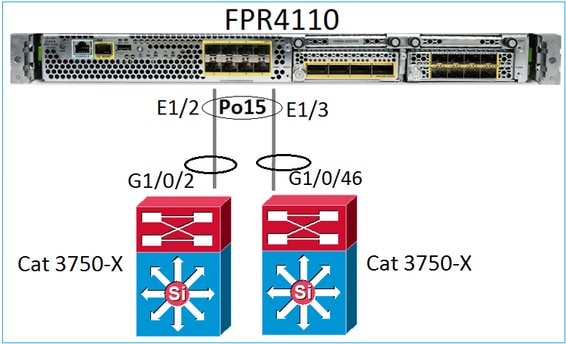
Solution
- In the case of 2960, you need to configure stacking (FlexStack).
- In the case of 3750-X/3850 and so on, you need to configure stacking (StackWise Plus).
- In the case of 4500, 6500, 6800, you need to use Virtual Switching System (VSS).
- In the case of Nexus 5K, 7K or 9K, you need to use Virtual Port-Channel (vPC).
- In a different case, you need to connect the FXOS to the same physical switch.
Case 3. FXOS Port-Channel Unassigned
Network Diagram
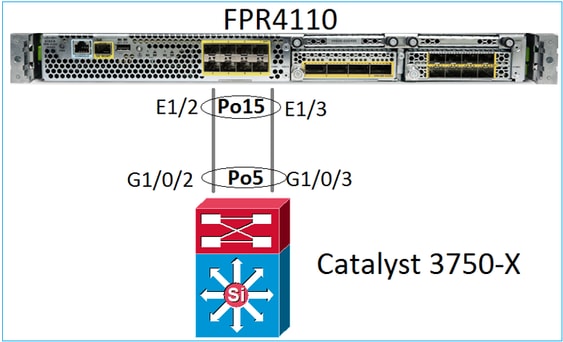
The Problem Symptoms
On FXOS side the Port-Channel members are Suspended:
FP4110-7-A(fxos)# show port-channel summary
Flags: D - Down P - Up in port-channel (members)
I - Individual H - Hot-standby (LACP only)
s - Suspended r - Module-removed
S - Switched R - Routed
U - Up (port-channel)
M - Not in use. Min-links not met
--------------------------------------------------------------------------------
Group Port- Type Protocol Member Ports
Channel
--------------------------------------------------------------------------------
15 Po15(SD) Eth LACP Eth1/2(s) Eth1/3(s)
48 Po48(SD) Eth NONE --The same on the switch side:
Switch# show etherchannel 5 summary … Group Port-channel Protocol Ports ------+-------------+-----------+----------------------------------------------- 5 Po5(SD) LACP Gi1/0/2(s) Gi1/0/3(s)
FXOS LACP counters shows packets that are sent and received:
FP4110-7-A(fxos)# show lacp counters
LACPDUs Marker Marker Response LACPDUs
Port Sent Recv Sent Recv Sent Recv Pkts Err
---------------------------------------------------------------------
port-channel15
Ethernet1/2 420839 452531 0 0 0 0 0
Ethernet1/3 420793 447409 0 0 0 0 0
FP4110-7-A(fxos)# show lacp counters
LACPDUs Marker Marker Response LACPDUs
Port Sent Recv Sent Recv Sent Recv Pkts Err
---------------------------------------------------------------------
port-channel15
Ethernet1/2 421026 452537 0 0 0 0 0
Ethernet1/3 420981 447416 0 0 0 0 0
On the switch side, the LACP counters also show packets that are sent, but not received:
Switch# show lacp 5 counters
LACPDUs Marker Marker Response LACPDUs
Port Sent Recv Sent Recv Sent Recv Pkts Err
---------------------------------------------------------------------
Channel group: 5
Gi1/0/2 452539 420223 0 0 0 0 0
Gi1/0/3 447232 415274 0 0 0 0 0
Switch# show lacp 5 counters
LACPDUs Marker Marker Response LACPDUs
Port Sent Recv Sent Recv Sent Recv Pkts Err
---------------------------------------------------------------------
Channel group: 5
Gi1/0/2 452540 420223 0 0 0 0 0
Gi1/0/3 447233 415274 0 0 0 0 0
The Root Cause
The problem, in this case, is that the FXOS Port-Channel is not assigned to the logical device (FTD application):

Solution
Assign the Port-Channel to the logical device.
Case 4. Health Alerts About Port-Channel Do Not Receive Any Packets
The device (FTD) sends every 5 minutes info about the interface traffic received on each interface that has a name configured and is UP. If there are no packets received in the last interval messages like this appear on FMC UI:

Recommended Action
From the FTD CLI, check the show traffic output and focus on the 5-minute input rate. For example,
Interface Port-channel10.14
INSIDE:
received (in 237938.740 secs):
2 packets 84 bytes
0 pkts/sec 0 bytes/sec
transmitted (in 237938.740 secs):
5 packets 140 bytes
0 pkts/sec 0 bytes/sec
1 minute input rate 0 pkts/sec, 0 bytes/sec
1 minute output rate 0 pkts/sec, 0 bytes/sec
1 minute drop rate, 0 pkts/sec
5 minute input rate 0 pkts/sec, 0 bytes/sec
5 minute output rate 0 pkts/sec, 0 bytes/sec
5 minute drop rate, 0 pkts/sec
Case 5. Health Alert on FMC: Port-Channel Disassociated or Interface Added
The Health alert states: "Interface with physical-name: "Port-Channel" disassociated." or ‘"Interface with physical-name: \"name_if\" added."
Recommended Action
This is a known, cosmetic issue tracked by Cisco bug ID CSCvb15074
Port-Channel Considerations
Design Considerations
Case 1. FTD/ASA Blade in HA
This setup is unsupported. The reason is the Port-Channel configuration on the switch side is incorrect and leads to traffic block on the standby device. Such design is only supported when you configure ASA or FTD in Cluster Spanned mode.
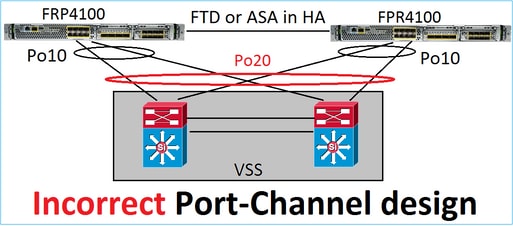

Warning: This scenario is incorrect in failover (high-availability).
This is the proper Port-Channel design for High Availability:
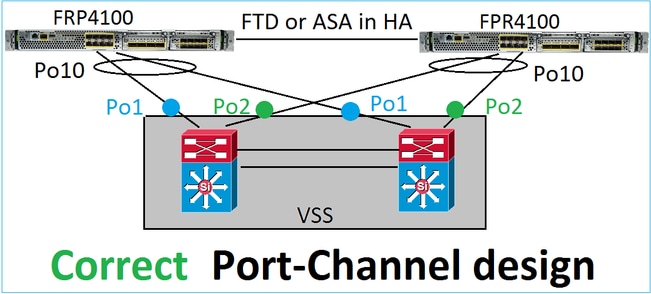
Related Information
Case 2. FTD/ASA in Cluster
Each firewall data interface Port-Channel uses Spanned mode (this is the only mode supported on Firepower platforms). From a design point of view, on the switch side, the switchports for a single data interface belong to one port-channel.
For example, in the case of FP9300 (2 chassis, 6 blades) the data ports can be configured like this:
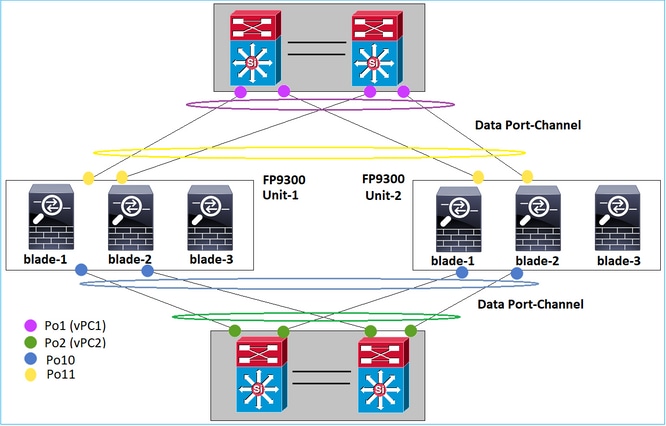
On the other hand, the Cluster Control Link (CCL) uses Individual port-channel mode and per best practices, the bandwidth must match the maximum capacity of each member. Additionally, in the case of Nexus, each port-channel belongs to a different vPC.
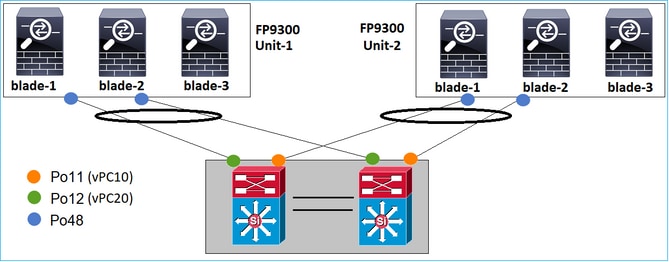
Similarly, in case of FP41xx:
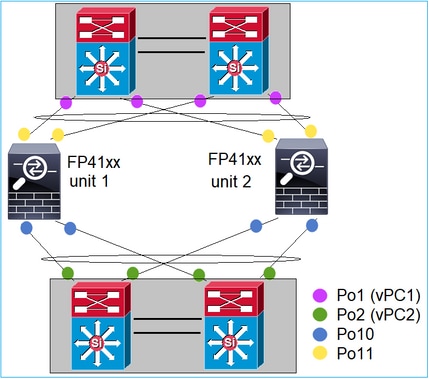
And the CCL:
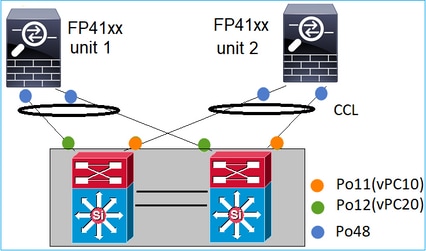
Case 3. Port-ChannelTerminated on FXOS
Port-Channel terminated on FXOS chassis. Here is an example of this design:

Case 4. Port-Channel Through FXOS
The Port-Channel goes through the FXOS chassis. Here is an example of this design:


Note: In the second scenario, there is no Port-Channel configured on the Firepower appliance.
Port-Channel terminated on FXOS vs Port-Channel through FXOS
|
Feature |
Comments |
|
Port-Channel terminated on FXOS chassis (MIO) |
Works as from FXOS 2.1.1 |
|
Port-Channel goes through FXOS chassis (MIO) |
|
Additional Considerations
LACP Graceful Convergence
In case of a Cluster setup (ASA or FTD), the recommendation is for LACP Graceful Convergence to be enabled on Nexus.
Frequently Asked Questions (FAQ)
Q. Is SSP port-channel hash distribution fixed or adaptive?
FXOS uses resilient hash distribution. This seems to be equivalent to the fixed hash-distribution mode described in Nexus 7000/9k documentation online. In resilient hashing, if a link fails, the flows assigned to the failed link are redistributed uniformly among the active links. The current flows through the active links are not rehashed and their packets are not delivered out of order. When a link is added to the port-channel or ECMP group, some of the flows hashed to the current links are rehashed to the new link, but not across all current links.
Q. What happens if the switchports connected to the Port-Channel go down? Does FTD monitor the physical link, or the port-channel?
If all the port-channel interface members go down, the port-channel does down as well. The Port Channel Operation State is shown as failed. From the FTD point of view, the port-channel is shown as down. On the other hand, in this rule, there is an exception: When the switches use stacking. With LACP, the system ID uses the stack MAC address from the active switch, and if the active switch changes, the LACP system ID can change. If the LACP system ID changes, the entire EtherChannel flaps, and there is STP re-convergence. Use the stack-mac persistent timer command to control whether or not the stack MAC address changes after an active switch failover.
Q. Would like to use the command "port-channel min-bundle 2" so that if one link in the port-channel goes down then the port-channel goes down and the firewall does a failover.
This option is not possible on FXOS chassis. As a workaround and whenever possible, configure the lacp min-links command on the peer switches.
Q. How to Capture LACP packets?
Case 1. Port-Channel terminated on the logical appliance (FTD/ASA)
- The Port-Channel is actually terminated at the chassis level (FXOS).
- You cannot capture LACP packets (ingress or egress) at neither chassis level (FXOS) nor application level (FTD/ASA).
Case 2. Port-Channel through the FTD – FTD interface deployed as inline-set:
inline-set set1
snort fail-open down
interface-pair INSIDE OUTSIDE
!
interface Ethernet1/2
nameif INSIDE
cts manual
propagate sgt preserve-untag
policy static sgt disabled trusted
!
interface Ethernet1/3
nameif OUTSIDE
cts manual
propagate sgt preserve-untag
policy static sgt disabled trusted
LACP Ethertype is 0x8809 (dec 34825):
firepower# capture CAP interface INSIDE ethernet-type 34825
firepower# show capture CAP
1: 21:15:00.403131 2894.0f57.271d 0180.c200.0002 0x8809 Length: 124 <-- LACP packet
0101 0114 8000 0017 dfd6 ec00 0016 8000
0223 3d00 0000 0214 8000 0017 dfd6 ec00
0015 8000 0222 3d00 0000 0310 8000 0000
0000 0000 0000 0000 0000 0000 0000 0000
0000 0000 0000 0000 0000 0000 0000 0000
0000 0000 0000 0000 0000 0000 0000 0000
0000 0000 0000 0000 0000 0000 0000
Case 3. Port-Channel through the FTD – FTD interface deployed as bridge-group mode:
interface Ethernet1/2
bridge-group 1
nameif INSIDE
cts manual
propagate sgt preserve-untag
policy static sgt disabled trusted
security-level 0
!
interface Ethernet1/3
bridge-group 1
nameif OUTSIDE
cts manual
propagate sgt preserve-untag
policy static sgt disabled trusted
security-level 0
!
interface BVI1
ip address 192.168.201.134 255.255.255.0
firepower# capture CAP interface INSIDE ethernet-type 34825
firepower# show capture CAP
1 packet captured
1: 21:21:29.731987 2894.0f57.271c 0180.c200.0002 0x8809 Length: 124 <-- LACP packet
0101 0114 8000 0017 dfd6 ec00 0015 8000
0222 7d00 0000 0214 0000 0000 0000 0000
0000 0000 0000 0000 0000 0310 8000 0000
0000 0000 0000 0000 0000 0000 0000 0000
0000 0000 0000 0000 0000 0000 0000 0000
0000 0000 0000 0000 0000 0000 0000 0000
0000 0000 0000 0000 0000 0000 0000
1 packet shown
Q. How to migrate from a single port to a Port-Channel?
This change requires a Maintenance Window (MW) and is intrusive. Once you migrate from a single interface to Port-Channel all configuration related to the single interface is disassociated from it. Once you create the Port-Channel there is a need to re-associate the same configuration with the newly configured Port-Channel, for example, NAT, Routing, VPN, and so on. For FTD there is a note in this document:
Configure an EtherChannel
For an ASA device the procedure is described in this document:
Converting In-Use Interfaces to a Redundant or EtherChannel Interface
Q. How to change FTD high availability (HA) link to Port-Channel?
This change requires a Maintenance Window (MW) and is intrusive. You must break the HA and reconfigure it. In the new HA pair specify as an HA link the Port-Channel. Related document:
Configure FTD High Availability on Firepower Appliances
Q. Firepower with ASA shows port-channel Up, physical interface status down
This is related to Cisco bug ID CSCvp03354
Q. Does it matter what to choose for the Port-Channel ID on the FMC? Does it have to match anything on the switch side?
No, it does not matter. You can use whatever Port-Channel ID you want.
Q. Under the Port-Channel Advanced tab, is there a need to do anything for the active/standby MAC?
If you plan to use the Port-Channel in Access Mode (no trunk) and you use High Availability (HA) setup, then Active/Standby MAC is highly recommended to be configured. This recommendation is not Port-Channel-specific but is applicable to any HA setup.
Q. Is it possible to configure descriptions for interface members of a Port-Channel?
Currently (FXOS 2.13.x), it is not supported. Check the latest FXOS configuration guide for additional details.
Q. It is possible to change the FXOS port-channel load-balancing algorithm?
Currently (FXOS 2.13.x), it is not supported. Check the latest FXOS configuration guide for additional details.
Q. Is it possible to configure the minimum number (min-links) of member interfaces in a port-channel in order to transition the port-channel into the bundled state?
Currently (FXOS 2.13.x), it is not supported. Check the latest FXOS configuration guide for additional details.
Related Information
Revision History
| Revision | Publish Date | Comments |
|---|---|---|
4.0 |
11-Apr-2024 |
Updated Style Requirements, and Formatting. |
3.0 |
15-May-2023 |
Updated Formatting and Language |
1.0 |
26-Mar-2020 |
Initial Release |
Contributed by Cisco Engineers
- Mikis ZafeiroudisCisco Customer Delivery Engineering Technical Leader
- Ilkin GasimovCisco Customer Delivery Engineering Technical Leader
- Mario Enrique Solorio ZertucheCisco Project Manager
Contact Cisco
- Open a Support Case

- (Requires a Cisco Service Contract)
 Feedback
Feedback